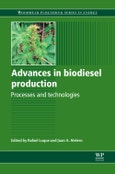This book provides a timely reference on the advances in the development of biodiesel fuels, production processes and technologies. Part one reviews the life cycle sustainability assessment and socio-economic and environmental policy issues associated with advanced biodiesel production, as well as feedstocks and fuel quality standards. This coverage is extended in Part two, with chapters focussing on the development of methods and catalysts essential to the improvement and optimisation of biodiesel production processes and technologies.
With its distinguished editors and international team of contributors, Advances in biodiesel production a standard reference for chemical, biochemical and industrial process engineers, as well as scientists and researchers in this important field.
- Provides a timely reference on the advances in the development of biodiesel fuels, production processes and technologies
- Reviews the life cycle sustainability assessment and socio-economic and environmental policy issues associated with advanced biodiesel production, as well as feedstocks and fuel quality standards
- Discusses the development of methods and catalysts essential to the improvement and optimisation of biodiesel production processes and technologies
Table of Contents
Contributor contact details
Woodhead Publishing Series in Energy
Chapter 1: Introduction to advanced biodiesel production
Abstract:
1.1 Introduction
1.2 Processes and technologies for advanced biodiesel production
1.3 New feedstocks for second generation biodiesel production
1.4 Glycerol as by-product of biodiesel production
1.5 Conclusions and outlook
1.6 Acknowledgements
Part I: Fundamental issues and assessment in advanced biodiesel production
Chapter 2: Life cycle sustainability assessment of second generation biodiesel
Abstract:
2.1 Introduction
2.2 Environmental sustainability of biodiesel
2.3 Socio-economic sustainability of biodiesel
2.4 Conclusions and future trends
2.5 Acknowledgements
2.6 Sources of further information and advice
Chapter 3: Socio-economic, environmental, and policy perspectives of advanced biodiesel production
Abstract:
3.1 Introduction
3.2 Socio-economic, environmental and policy limitations of first generation biodiesels
3.3 Economic potential and limitations of second and third generation biodiesels
3.4 New impacts on energy security
3.5 New impacts on land and food safety
3.6 Effects on international trade and sustainable development
3.7 What are the right policies for next generation biodiesels?
3.8 Conclusions
Chapter 4: Feedstocks for advanced biodiesel production
Abstract:
4.1 Introduction
4.2 Feedstocks for first generation biodiesel
4.3 Feedstocks for second generation biodiesel
4.4 Other feedstocks for biodiesel production
4.5 Feedstocks for advanced biodiesel production
4.6 Future trends: the biorefinery concept
4.7 Acknowledgements
Chapter 5: Advances in biodiesel quality control, characterisation and standards development
Abstract:
5.1 Introduction
5.2 Characterisation, analysis techniques and quality control of feedstocks
5.3 Characterisation, analysis techniques and quality control of biodiesel
5.4 Development of standards for biodiesel quality and use
5.5 Future trends
Part II: Advanced biodiesel production processes and technologies
Chapter 6: Advances in biodiesel catalysts and processing technologies
Abstract:
6.1 Introduction
6.2 Current production technology for biodiesel
6.3 New types of catalysts
6.4 Innovative reaction conditions
6.5 Advanced biodiesel reactor design
6.6 Production of biodiesel with simultaneous derivation of glycerol
6.7 In situ transesterification
6.8 Conclusions
Chapter 7: Biodiesel from waste oils and fats
Abstract:
7.1 Introduction
7. 2 Waste oils and fats
7.3 Technology for biodiesel production from waste lipids
7.4 Advantages and limitations
7.5 Concluding remarks and future trends
Chapter 8: Biodiesel from microbial oil
Abstract:
8.1 Introduction
8.2 Heterotrophic microorganisms for oil production
8.3 Carbon sources for microorganism production
8.4 Biodiesel production from heterotrophic microorganisms
8.5 Suitability of biodiesel
8.6 Enhancement of microbial oil production
8.7 Conclusions and future trends
Chapter 9: Microalgae processing for biodiesel production
Abstract:
9.1 Introduction
9.2 Microalgae biomass downstream processing
9.3 Cell disruption methods
9.4 Lipids extraction from microalgae
9.5 Advanced biodiesel production from microalgae
9.6 Process integration: the biorefinery concept
9.7 Conclusions
Chapter 10: Valorization of the glycerol by-product of biodiesel production
Abstract:
10.1 Introduction
10.2 Composition and purification of glycerol produced from biodiesel
10.3 Applications and valorization of glycerol
10.4 Advantages and limitations of the use of crude glycerol from biodiesel production
10.5 Future trends
Supply chains, techno-economic assessment and market development for second generation biodiesel
Index








